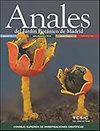Wild edible plant species used in the Ağrı province, eastern Turkey
IF 0.7
4区 生物学
Q4 PLANT SCIENCES
引用次数: 6
Abstract
Wild edible plant species found in Agri are nutritionally and economically relevant. Plants are collected by the villagers and brought to the market for sale in the spring. Interest in these plants responds to the increasing demand for organic and natural food. In this study, 350 in-depth face-to-face interviews with villagers about the edible plants used in Agri (7 districts, 35 villages) were conducted in the region from April 2016 to October 2017. The species, parts used and their consumption and preservation techniques were analyzed and documented. Some of the wild edible plant species are consumed cured or canned, raw or cooked, dried, and some are frozen. The collected 100 wild edible species belong to 25 different plant families. Species are consumed as vegetables (91), spices (19), beverages (16), subterranean parts (5), fruits (3), seeds (3) and exudates (2). The most important species according to their cultural importance were: Amaranthus retroflexus, Beta trigyna, Gundelia tournefortii, Mentha longifolia, Polygonum persicaria, Rumex scutatus, Tragopogon porrifolius subsp. longirostris, and Urtica dioica. Leaves and young shoots were the most frequently used parts. Our study shows that wild edible plants are still well known and used by the local people of Agri as a food source. The documented data on these plants herein could be used as baseline information for further investigations on nutritional contents, as they could have the potential to become valuable nutrition sources.土耳其东部Ağrı省使用的野生食用植物物种
在农业中发现的野生可食用植物物种具有营养和经济意义。村民们收集植物,在春天送到市场上出售。对这些植物的兴趣反映了对有机和天然食品日益增长的需求。本研究于2016年4月至2017年10月对该地区7个区、35个村的村民进行了350次关于农业食用植物的深度面对面访谈。对其种类、使用部位、消费和保存技术进行了分析和记录。一些野生可食用植物物种被腌制或罐装,生的或煮熟的,干燥的,一些是冷冻的。收集到的100种野生食用植物属于25个不同的植物科。作为蔬菜(91种)、香料(19种)、饮料(16种)、地下部位(5种)、果实(3种)、种子(3种)和分泌物(2种)被食用。按文化重要性排序,最重要的种是:逆花苋(Amaranthus retroflexus)、trigyna、tournefortii、Mentha longifolia、Polygonum persicaria、Rumex scustatus、Tragopogon porrifolius subsp。长鼻草和荨麻。树叶和嫩枝是最常用的部位。我们的研究表明,野生可食用植物仍然是Agri当地人民所熟知和使用的食物来源。这些植物的记录数据可以作为进一步调查营养成分的基线信息,因为它们有可能成为有价值的营养来源。
本文章由计算机程序翻译,如有差异,请以英文原文为准。
求助全文
约1分钟内获得全文
求助全文
来源期刊

Anales Del Jardin Botanico De Madrid
PLANT SCIENCES-
CiteScore
1.20
自引率
0.00%
发文量
9
审稿时长
>12 weeks
期刊介绍:
Anales del Jardín Botánico de Madrid features original and unpublished articles in fields such as taxonomy and systematics of all plant groups and fungi, including related fields like biogeography, bioinformatics, conservation, ecophysiology, phylogeny, phylogeography, functional morphology, nomenclature and plant-animal relations, as well as reviews and summary works. Anales del Jardín Botánico de Madrid is published half-yearly, with two issues appearing in June and December.
 求助内容:
求助内容: 应助结果提醒方式:
应助结果提醒方式:


